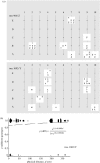The spatial scale of genetic differentiation in a model organism: the wild yeast Saccharomyces paradoxus
- PMID: 17028086
- PMCID: PMC1764930
- DOI: 10.1098/rstb.2006.1922
The spatial scale of genetic differentiation in a model organism: the wild yeast Saccharomyces paradoxus
Abstract
Little information is presently available on the factors promoting genetic divergence in eukaryotic microbes. We studied the spatial distribution of genetic variation in Saccharomyces paradoxus, the wild relative of Saccharomyces cerevisiae, from the scale of a few centimetres on individual oak trees to thousands of kilometers across different continents. Genealogical analysis of six loci shows that isolates from Europe form a single recombining population, and within this population genetic differentiation increases with physical distance. Between different continents, strains are more divergent and genealogically independent, indicating well-differentiated lineages that may be in the process of speciation. Such replicated populations will be useful for studies in population genomics.
Figures



Similar articles
-
Population genomics reveals structure at the individual, host-tree scale and persistence of genotypic variants of the undomesticated yeast Saccharomyces paradoxus in a natural woodland.Mol Ecol. 2017 Feb;26(4):995-1007. doi: 10.1111/mec.13954. Epub 2017 Jan 27. Mol Ecol. 2017. PMID: 27988980
-
Allopatric divergence, secondary contact, and genetic isolation in wild yeast populations.Curr Biol. 2007 Mar 6;17(5):407-11. doi: 10.1016/j.cub.2006.12.047. Epub 2007 Feb 15. Curr Biol. 2007. PMID: 17306538
-
Population genetics of the wild yeast Saccharomyces paradoxus.Genetics. 2004 Jan;166(1):43-52. doi: 10.1534/genetics.166.1.43. Genetics. 2004. PMID: 15020405 Free PMC article.
-
Saccharomyces paradoxus and Saccharomyces cerevisiae reside on oak trees in New Zealand: evidence for migration from Europe and interspecies hybrids.FEMS Yeast Res. 2010 Nov;10(7):941-7. doi: 10.1111/j.1567-1364.2010.00681.x. Epub 2010 Sep 24. FEMS Yeast Res. 2010. PMID: 20868381
-
The rise of yeast population genomics.C R Biol. 2011 Aug-Sep;334(8-9):612-9. doi: 10.1016/j.crvi.2011.05.009. Epub 2011 Jul 1. C R Biol. 2011. PMID: 21819942 Review.
Cited by
-
Geographic delineations of yeast communities and populations associated with vines and wines in New Zealand.ISME J. 2012 Jul;6(7):1281-90. doi: 10.1038/ismej.2011.195. Epub 2011 Dec 22. ISME J. 2012. PMID: 22189497 Free PMC article.
-
Shifts in the intensity of purifying selection: an analysis of genome-wide polymorphism data from two closely related yeast species.Genome Res. 2010 Nov;20(11):1558-73. doi: 10.1101/gr.108993.110. Epub 2010 Sep 4. Genome Res. 2010. PMID: 20817943 Free PMC article.
-
Divergence in wine characteristics produced by wild and domesticated strains of Saccharomyces cerevisiae.FEMS Yeast Res. 2011 Nov;11(7):540-51. doi: 10.1111/j.1567-1364.2011.00746.x. Epub 2011 Sep 2. FEMS Yeast Res. 2011. PMID: 22093681 Free PMC article.
-
Pherotypes are driving genetic differentiation within Streptococcus pneumoniae.BMC Microbiol. 2009 Sep 7;9:191. doi: 10.1186/1471-2180-9-191. BMC Microbiol. 2009. PMID: 19735561 Free PMC article.
-
Population genomics of domestic and wild yeasts.Nature. 2009 Mar 19;458(7236):337-41. doi: 10.1038/nature07743. Epub 2009 Feb 11. Nature. 2009. PMID: 19212322 Free PMC article.
References
-
- Aa E, Townsend J.P, Adams R.I, Nielsen K.M, Taylor J.W. Population structure and gene evolution in Saccharomyces cerevisiae. FEMS Yeast Res. 2006;6:702–715. - PubMed
-
- Agapow P, Burt A. Indices of multilocus linkage disequilibrium. Mol. Ecol. Notes. 2001;1:101–102.
-
- Burt A, Dechairo B.M, Koenig G.L, Carter D.A, White T.J, Taylor J.W. Molecular markers reveal differentiation among isolates of Coccidioides immitis from California, Arizona and Texas. Mol. Ecol. 1997;6:781–786. doi:10.1046/j.1365-294X.1997.00245.x - DOI - PubMed
-
- Coyne J.A, Orr H.A. Sinauer; Sunderland, MA: 2004. Speciation.
-
- Fay J.C, Benavides J.A. Evidence for domesticated and wild populations of Saccharomyces cerevisiae. PLoS Genet. 2005;1:66–71. doi:10.1371/journal.pgen.0010005 - DOI - PMC - PubMed
Publication types
MeSH terms
LinkOut - more resources
Full Text Sources
Molecular Biology Databases

